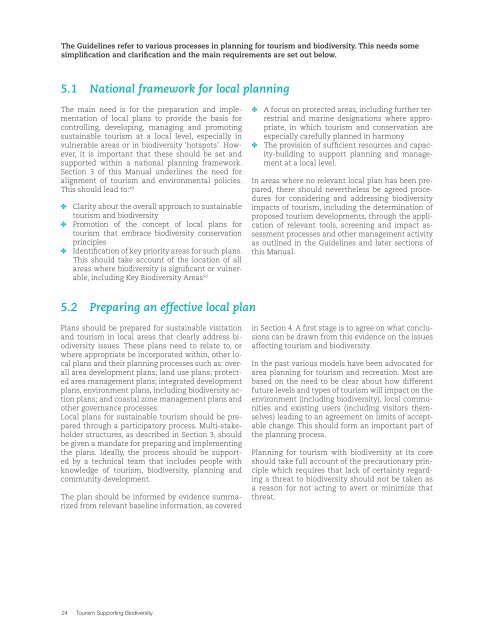1Tgjonb
1Tgjonb
1Tgjonb
You also want an ePaper? Increase the reach of your titles
YUMPU automatically turns print PDFs into web optimized ePapers that Google loves.
The Guidelines refer to various processes in planning for tourism and biodiversity. This needs somesimplification and clarification and the main requirements are set out below.5.1 National framework for local planningThe main need is for the preparation and implementationof local plans to provide the basis forcontrolling, developing, managing and promotingsustainable tourism at a local level, especially invulnerable areas or in biodiversity ‘hotspots’. However,it is important that these should be set andsupported within a national planning framework.Section 3 of this Manual underlines the need foralignment of tourism and environmental policies.This should lead to: 49✤Clarity about the overall approach to sustainabletourism and biodiversity✤Promotion of the concept of local plans fortourism that embrace biodiversity conservationprinciples✤Identification of key priority areas for such plans.This should take account of the location of allareas where biodiversity is significant or vulnerable,including Key Biodiversity Areas 50✤A focus on protected areas, including further terrestrialand marine designations where appropriate,in which tourism and conservation areespecially carefully planned in harmony✤The provision of sufficient resources and capacity-buildingto support planning and managementat a local level.In areas where no relevant local plan has been prepared,there should nevertheless be agreed proceduresfor considering and addressing biodiversityimpacts of tourism, including the determination ofproposed tourism developments, through the applicationof relevant tools, screening and impact assessmentprocesses and other management activityas outlined in the Guidelines and later sections ofthis Manual.5.2 Preparing an effective local planPlans should be prepared for sustainable visitationand tourism in local areas that clearly address biodiversityissues. These plans need to relate to, orwhere appropriate be incorporated within, other localplans and their planning processes such as: overallarea development plans; land use plans; protectedarea management plans; integrated developmentplans, environment plans, including biodiversity actionplans; and coastal zone management plans andother governance processes.Local plans for sustainable tourism should be preparedthrough a participatory process. Multi-stakeholderstructures, as described in Section 3, shouldbe given a mandate for preparing and implementingthe plans. Ideally, the process should be supportedby a technical team that includes people withknowledge of tourism, biodiversity, planning andcommunity development.The plan should be informed by evidence summarizedfrom relevant baseline information, as coveredin Section 4. A first stage is to agree on what conclusionscan be drawn from this evidence on the issuesaffecting tourism and biodiversity.In the past various models have been advocated forarea planning for tourism and recreation. Most arebased on the need to be clear about how differentfuture levels and types of tourism will impact on theenvironment (including biodiversity), local communitiesand existing users (including visitors themselves)leading to an agreement on limits of acceptablechange. This should form an important part ofthe planning process.Planning for tourism with biodiversity at its coreshould take full account of the precautionary principlewhich requires that lack of certainty regardinga threat to biodiversity should not be taken asa reason for not acting to avert or minimize thatthreat.24 Tourism Supporting Biodiversity


